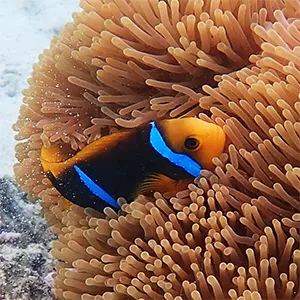
Divers find a new clownfish species living inside poisonous tentacles of a sea anemone
For years, divers in French Polynesia swam past an orange tailed clownfish tucked into a sea anemone. It looked like a familiar species, but it turned out to be a new species named Amphiprion maohiensis.
A research team now confirms it is a species of its own found in French Polynesia. The finding rests on anatomy, photographs, and DNA evidence from across the South Pacific.
A peer-reviewed study confirmed that the orange tailed anemonefish in French Polynesia is a distinct species. Scientists had long grouped these fish with a widespread lookalike that ranges from Australia to Micronesia.
Researchers noticed two consistent looks, or morphs, across that broad range. One had a white tail in the west, the other an orange tail toward the east, a pattern that hinted at cryptic speciation, the formation of new species that remain outwardly similar.
Lead work came from James L. O’Donnell of the Department of Ecology and Evolutionary Biology, University of California Santa Cruz (UCSC). He and collaborators combined field collecting with modern genome analysis to resolve the split.
Studying Amphiprion maohiensis
The team used nets to sample fish from French Polynesia, Micronesia, Papua New Guinea, and the Solomon Islands.
They also examined 800 diver photographs and scored 565 individuals for tail color to check how the morphs map across islands.
Scientists compared body proportions using morphometrics, the quantitative measurement of form. French Polynesian fish showed longer dorsal and pectoral fins, small but consistent differences that separated them from their western cousins.
They then analyzed mitochondrial DNA from Amphiprion maohiensis – the compact genetic material inherited from the maternal line.
It differed by about 1.5 percent between the French Polynesian group and Micronesia, a split consistent with roughly 1.5 million years of separation.
Whole genomics, the study of complete DNA across the genome, agreed with the mitochondrial picture. Sequencing identified about 27.7 million variable sites and clearly clustered the Polynesian fish apart from the western fish.
“We describe here as a new species: the Polynesian anemonefish, Amphiprion maohiensis,” said O’Donnell. He added that the discovery shows how even familiar reef fish can hide long overlooked branches of evolution beneath their vivid colors.
Amphiprion maohiensis is unique
The new species carries a light orange to dark yellow body with two pale bars. All fins are orange, and the tail is orange throughout French Polynesia.
Color alone did not define the species across the Pacific. A few orange tailed fish appear west of Fiji, and a few white tailed fish appear farther east, so the team leaned on diagnostic characters that included fin lengths and genetics.
The distribution pattern was sharp in citizen science images checked by the team. Eastern sites showed the orange tail, while western sites were dominated by white tails, with only rare exceptions.
A genetic clock based on mitochondrial markers pointed to a split that started well before modern reefs reached their current form. That timing fits with ocean currents that limit larval exchange across the central Pacific.

Life in a dangerous neighborhood
Amphiprion maohiensis lives among the tentacles of the magnificent sea anemone. Those tentacles are armed with nematocysts, stinging capsules that fire tiny harpoons loaded with venom, yet the fish is unharmed.
Recent work points to a chemical shield in the fish’s skin mucus. A paper reported that anemonefish regulate sialic acids in their mucus to avoid triggering these stinging cells.
Both partners benefit in this partnership. The mutualism shelters the fish from predators while the anemone feeds on leftovers and receives better water flow from the fish’s constant fanning.
Polynesian reefs host large beds of this anemone, making a ready home for the new fish. That widespread host likely helped the species persist across many islands.
Why the name matters
The species name maohiensis honors maohi, a Polynesian term meaning belonging of native land.
Scientific names cannot include apostrophes under the International Commission on Zoological Nomenclature code (ICZN), so the apostrophe was removed.
The host anemone’s accepted name is now Radianthus magnifica rather than Heteractis magnifica. The World Register of Marine Species database lists Radianthus magnifica as the valid name and tracks its synonymy.
Naming a species is not just a label. It signals that the fish has its own history and boundaries, which guides surveys, collections, and any future protective rules.
Subtle traits will help divers and researchers identify it. Slightly longer dorsal and pectoral fins, together with the orange tail in French Polynesia, separate it from similar fish elsewhere.
Protecting Amphiprion maohiensis
Reef fish often hide diversity in plain sight. Recognizing monophyletic groups, lineages that include all descendants of a single ancestor, turns rough categories into precise maps of biodiversity.
A species restricted to French Polynesia needs focused attention. Local management and monitoring can now track this fish rather than lumping it with a broad Pacific species.
Citizen photographs proved essential in this case. Structured analysis of those images added geographic resolution that would be costly to obtain with sampling alone.
Clear names also aid aquarists, tour guides, and park managers. Everyone speaks the same language when a new name marks a distinct fish with a defined range.
The study is published in ZooKeys.
—–
Like what you read? Subscribe to our newsletter for engaging articles, exclusive content, and the latest updates.
Check us out on EarthSnap, a free app brought to you by Eric Ralls and Earth.com.
—–













